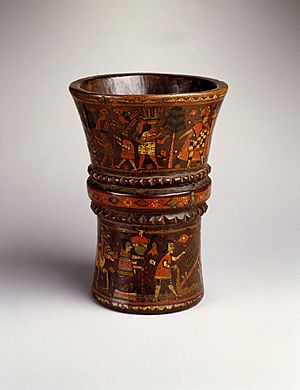Qiru facts for kids
A qiru (pronounced KEE-roo) is an old drinking cup from the Andes mountains in South America. People used these cups to drink liquids like chicha, which is a traditional corn beer. Qirus could be made from different materials such as wood, clay, silver, or gold. They were often used during special parties and ceremonies in ancient Andean cultures.
Qirus were decorated in a unique way. First, artists would carve a shallow design onto the cup's surface. Then, they would fill these carved lines with a special mix of plant resin and colorful pigments, like a bright red color called cinnabar. The designs often featured detailed lines that formed shapes like triangles, squares, and diamonds. These shapes were usually arranged in two to four rows around the cup.
Some qirus have beautiful, hand-painted geometric patterns, similar to traditional pottery from a place called Písac. Other qirus might show pictures of stories or events that could have been real historical moments. You often find them alone, but sometimes they are found with other types of pottery from Peru. Qiru making was most popular between the years 1000 and 1200 CE, but people continued to make them even after Europeans arrived. Many qirus have been found in Moquegua, Peru. You can see some on display at the Museo Contisuyo in Moquegua.

During the time of the Inca Empire, qirus were usually made in matching pairs. This was because it was customary for two people to drink together during ceremonies. Both cups in a pair would be exactly the same size, shape, and have the same decorations. These pairs were often used for toasts during important events. They were also given as gifts, along with textiles, to show how generous the Inca rulers were.

Qirus and Culture
The making of qirus started a very long time ago, between 100 and 600 CE. This was a period when societies in the Andes became more organized, and there were more powerful leaders. Special ceremonies played a big part in bringing different Andean cultures together. These ceremonies also helped create different social classes, showing who had more power and authority. Qirus were very important in these ceremonies.
Political Importance
The political importance of the qiru can be seen in the huge stone statues found at the center of the ancient city of Tiwanaku in Bolivia. These statues show important leaders holding qirus in their hands. The statues are very grand, showing the leaders in fancy clothes, highlighting their high status and power.
Religious Connections
Qirus also had a strong religious meaning. Chicha, the corn beer, was an important drink used in rituals and as an offering in ancient Andean culture. Chicha was served in qirus. A special goblet-shaped qiru was closely linked to a "Sacrifice Ceremony" often shown on pottery made by the Moche culture.
Many pictures of qirus show a corn plant growing out of the cup. These images suggest that qirus were used across the Andes to pour blood onto the ground. This was done to help ensure a good farming season. The qirus used for this special purpose were often made of metal instead of clay or wood, and they looked different from the usual beaker-shaped qirus.
See also
 In Spanish: Quero para niños
In Spanish: Quero para niños

